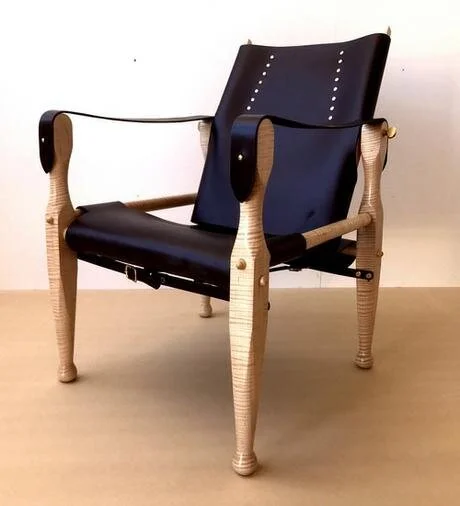Roorkee Chair
Josh Cohen
$2100 AUD
Presented by Hugh Anderson & Mike Green (assistant)
The Roorkee Chair belongs to the genre of Campaign Furniture. In the days of empires, there was a need for rugged, sturdy and simple furniture for military campaigns. Originally designed to be used by British Army Officers in India. They needed a chair that was light in weight, could be folded up, carried around easily and loaded onto a pack horse.
Named in honour of the headquarters of Indian Army Corps of Engineers at Roorkee, United Provinces, India and mainstay of the Army and Navy Stores catalogues, the Roorkee chair was among the most popular models of campaign chairs used by British Officers from approximately 1898 to the start of World War ll. It also needed to be comfortable and able to adapt to use on uneven terrain without breaking. It is an engineering masterpiece, using minimal materials and able to provide comfortable seating, especially on uneven ground, due to the tapered mortices and tenons which join the rails to the leg.
It has had a revival in recent years, thanks to Christopher Schwarz who has researched and written a comprehensive book on Campaign Furniture (although it appears to have been continuously available in South Africa as a safari chair). It was inspirational for many modern furniture designers, especially Kaare Klint, generally regarded as the father of modern Danish furniture design. His “Safari Chair” was popular in many European and American homes.
The chairs were originally made in either mahogany or oak (or whatever local timbers were available) and the seat material either leather or canvas.The design for the class is based on the Roorkee chair in Schwarz’s book, with minor variations in aesthetics, process and hardware, gleaned from the experience of making many these chairs over the last five years. The timber needs to be a hardwood, such as The timber can be finished in a variety of ways, either shellac and beeswax, or a wipe-on finish like tung oil, Minwax Poly or Osmo. The leather is an Italian 3.5-4.0mm double butt belt leather, available in a variety of colours, such as black, brown, tan or cognac is available in 3.5mm hides.
The leather work should present little difficulty to a wood worker. There is the layout on a leather hide of templates for cutting of the leather for the seat, back rest and thigh strap, and the use of a strap cutter to produce all the straps needed. Straps are attached to the seat and back leathers using copper rivets, they are not sewn.
You will have a most comfortable chair to relax into, and possibly one of the best chairs to take camping to sit around a camp fire.
When
Fri 12th to Mon 15th June 2026
9:00am to 5:00pm
(4 Days)
Location
Melbourne Guild of Fine Woodworking.
14 Cottage St, Blackburn










